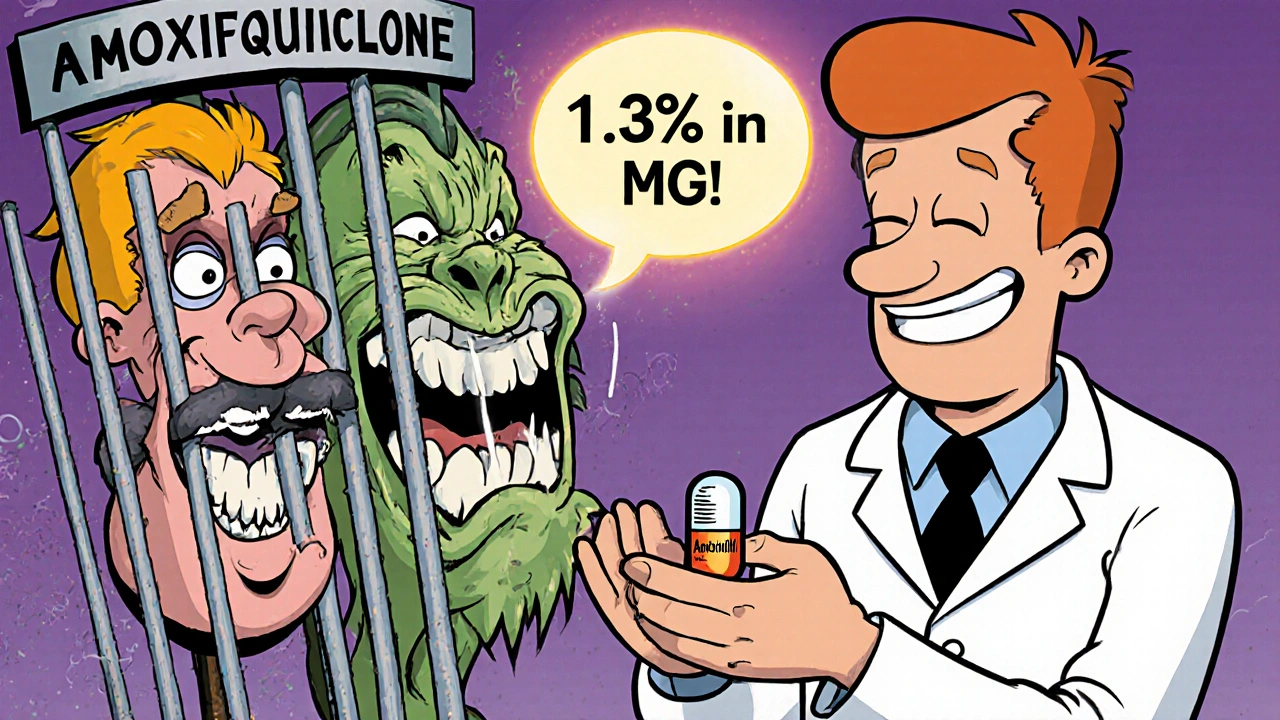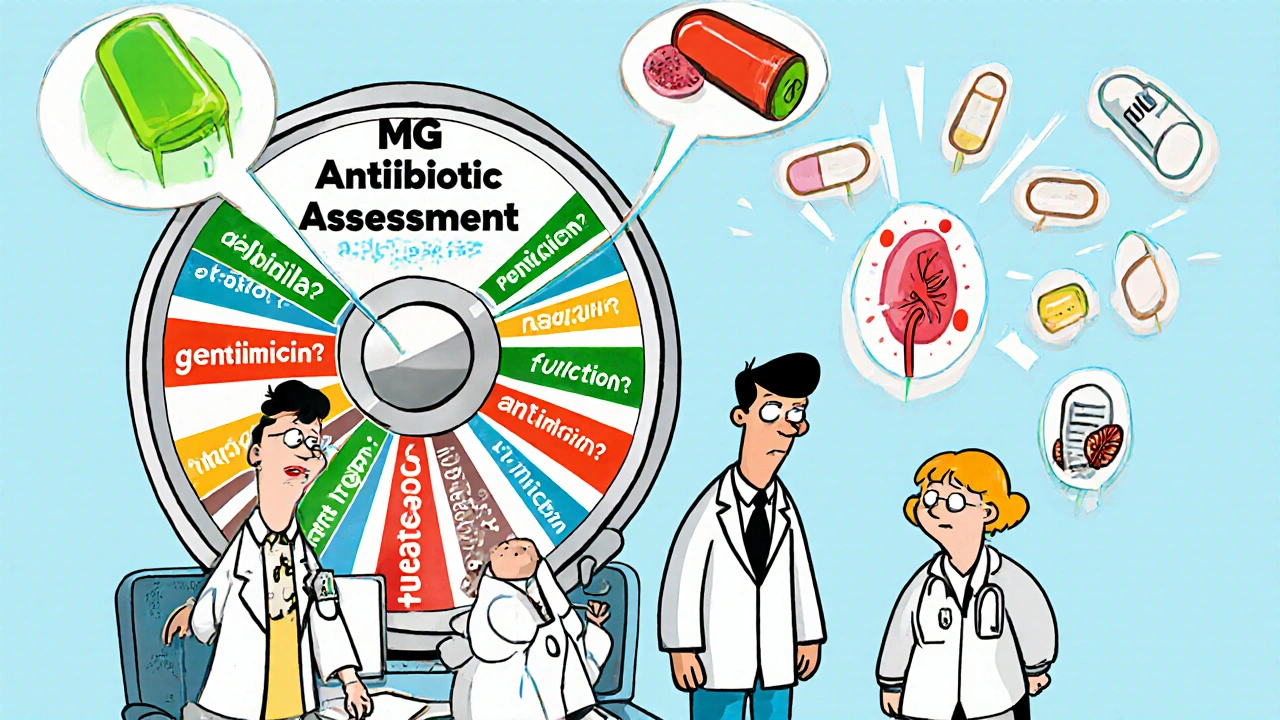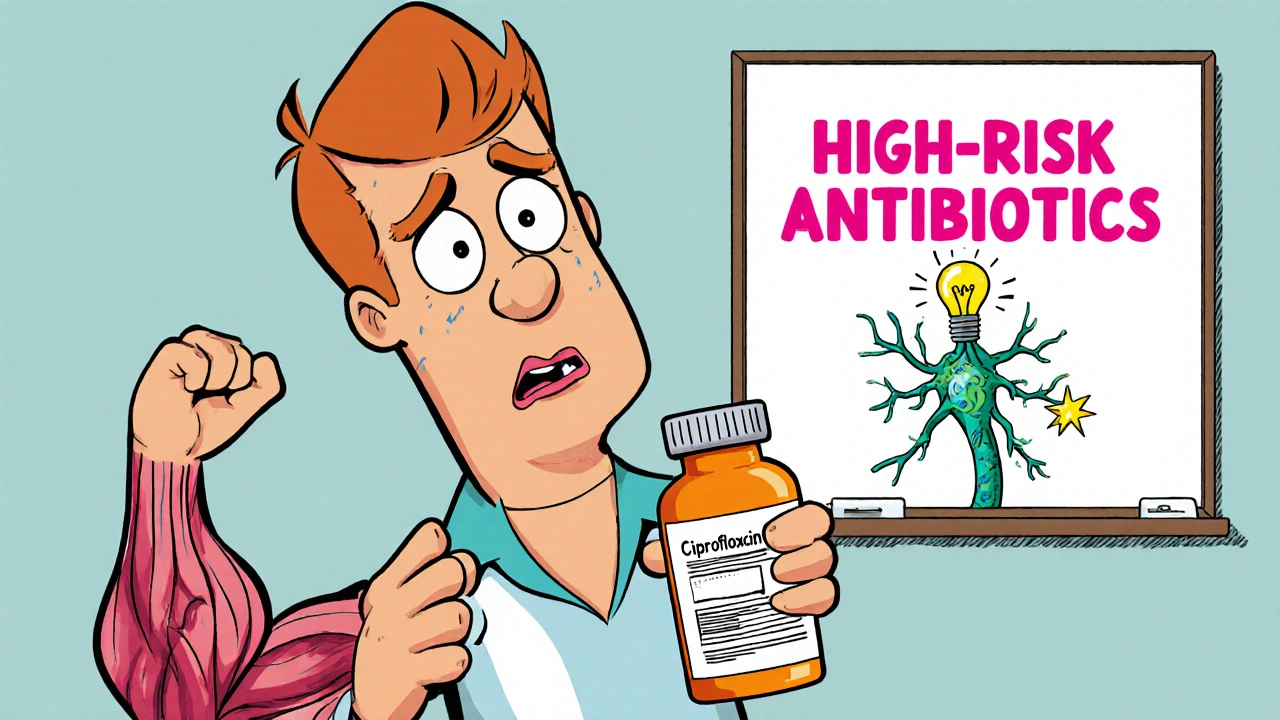MG Antibiotic Risk Calculator
Important: This tool helps assess antibiotic risk based on article data. Always consult your MG specialist before making medical decisions.
Your Risk Assessment
When you have myasthenia gravis (MG), even a simple infection can become a dangerous situation-not just because of the illness itself, but because of the antibiotics used to treat it. Some common antibiotics can make your muscle weakness worse, sometimes leading to a life-threatening myasthenic crisis. Yet avoiding antibiotics altogether isn’t an option either. Infections are one of the most common triggers for MG flare-ups. So how do you balance treating an infection without triggering a dangerous reaction? The answer isn’t black and white anymore.
What Happens When Antibiotics Interfere With Neuromuscular Signals
Myasthenia gravis attacks the connection between nerves and muscles. Normally, nerves release acetylcholine, a chemical that tells your muscles to contract. In MG, your body’s immune system destroys many of the receptor sites that receive this signal. So your muscles don’t get the message properly, and you get weak-eyelids droop, swallowing becomes hard, arms feel heavy, and breathing can become a struggle. Certain antibiotics make this worse. They don’t cause MG, but they can block the last few remaining acetylcholine receptors or interfere with how acetylcholine is released. This pushes the neuromuscular junction past its breaking point. The result? Sudden, severe weakness that can mimic a bad flare-up, but it’s actually drug-induced.Which Antibiotics Are Riskiest for MG Patients?
Not all antibiotics are created equal when you have MG. Some carry clear red flags. Others are safer than you might think.- High-risk antibiotics: Fluoroquinolones (ciprofloxacin, levofloxacin, moxifloxacin), macrolides (azithromycin, clarithromycin, erythromycin), and aminoglycosides (gentamicin, tobramycin, neomycin) are the biggest concerns. The FDA has issued black box warnings for fluoroquinolones and telithromycin (a macrolide) specifically for MG patients. Aminoglycosides are especially dangerous because they directly block muscle receptors.
- Intermediate-risk: Tetracyclines, trimethoprim-sulfamethoxazole, and linezolid need caution. They’re not as dangerous as the top-tier offenders, but they’ve been linked to worsening symptoms in some cases.
- Lower-risk options: Penicillins-like amoxicillin, ampicillin, and penicillin V-have shown the lowest risk in recent studies. A 2024 analysis of 918 antibiotic courses in 365 MG patients found only a 1.3% exacerbation rate with penicillins, compared to about 2% for fluoroquinolones and macrolides.
Here’s the surprising part: the difference in risk between fluoroquinolones/macrolides and penicillins isn’t as big as doctors once thought. The 2024 Cleveland Clinic study, the largest of its kind, found that while high-risk antibiotics carry danger, the overall rate of worsening symptoms is still low-about 2% in total. That means for most stable MG patients, these drugs aren’t automatically off-limits. But they’re not risk-free either.
Who’s Most at Risk for Antibiotic-Induced Weakness?
Not every MG patient reacts the same way. Some factors make you much more vulnerable:- Recent hospitalization or ER visit: If you’ve been hospitalized or went to the ER for MG symptoms in the last six months, your risk jumps. Your system is already stressed.
- Female sex: Women with MG are more likely to experience antibiotic-triggered worsening, according to the same Cleveland Clinic study.
- Diabetes: Having diabetes increases your risk by over 3%, likely because of how it affects nerve function and immune response.
Age and kidney problems also matter. Older patients and those with reduced kidney function are slower to clear antibiotics from their bodies. That means drugs stick around longer, increasing the chance of interference with your neuromuscular junction.

The Bigger Problem: Infections Are the Real Trigger
It’s easy to blame the antibiotic when your muscles get weaker after taking it. But here’s what the data shows: in 88.2% of cases where MG worsened after an antibiotic, the infection itself was the main cause.That’s critical. It means you can’t assume the drug is the villain. Sometimes, the infection is so bad it’s already pushing your body past its limit. The antibiotic might just be the last straw-or, worse, the only thing keeping you alive.
Let’s say you have pneumonia. Your breathing is already labored. If you don’t treat it, you could go into respiratory failure. In that case, even a high-risk antibiotic like levofloxacin might be the right choice. The risk of not treating the infection is far greater than the risk of the drug.
What Should You Do If You Need an Antibiotic?
There’s no one-size-fits-all answer, but here’s a practical plan:- Always talk to your MG specialist first. Don’t wait for your primary care doctor to prescribe something. Your neurologist or MG clinic needs to be involved in the decision.
- Ask: Is there a safer alternative? If you have a sinus infection or urinary tract infection, amoxicillin is often just as effective as ciprofloxacin-and far safer.
- If a higher-risk drug is necessary, monitor closely. Watch for signs of worsening: trouble swallowing, slurred speech, shortness of breath, or new eyelid drooping. Call your doctor immediately if any of these appear.
- Don’t delay treatment. If you’re sick and weak, don’t wait to start antibiotics. Delaying can make the infection worse, which is more dangerous than the drug.
- Make sure every provider knows you have MG. Add it to your medical records, your pharmacy profile, and even your phone’s health app. Pharmacists can flag risky prescriptions before they’re filled.

Why Guidelines Are Changing
For years, doctors were told to avoid fluoroquinolones and macrolides in MG patients entirely. That advice came from small case reports and fear, not large-scale data. Now, the Cleveland Clinic study-with over 900 antibiotic courses tracked-shows the risk is real but manageable. It’s not zero, but it’s not as high as once believed.This is changing how neurologists think. Instead of blanket bans, they’re moving toward personalized risk assessment. A 65-year-old woman with diabetes who was hospitalized last month? Avoid fluoroquinolones. A 40-year-old man with stable MG, no recent hospital visits, and a bad UTI? Amoxicillin might be overkill-levofloxacin could be fine with close monitoring.
What’s Next for MG Patients and Antibiotics?
The future is about smarter decisions, not just avoidance. Researchers are now looking into genetic markers that might predict who’s most likely to react badly to certain antibiotics. Clinical decision tools are being developed to help doctors choose the safest drug based on your specific MG status, age, kidney function, and recent history.For now, the message is clear: don’t panic. Don’t refuse needed antibiotics. But don’t assume all antibiotics are safe, either. Work with your care team. Know your risk factors. Ask questions. And remember-in MG, the infection is often the real enemy. The right antibiotic, chosen wisely, is your ally.
Can amoxicillin make myasthenia gravis worse?
Amoxicillin is considered one of the safest antibiotic options for people with myasthenia gravis. A 2024 study of 918 antibiotic courses in MG patients found only a 1.3% chance of symptom worsening with penicillins like amoxicillin-significantly lower than fluoroquinolones or macrolides. It’s routinely recommended by MG clinics as a first-line choice for common infections like sinusitis or strep throat.
Are fluoroquinolones always dangerous for MG patients?
Fluoroquinolones carry a black box warning from the FDA and can worsen MG symptoms, but they’re not automatically off-limits. A 2024 study found the overall risk of exacerbation is about 2%, similar to macrolides. For stable patients without recent hospitalizations, these antibiotics may be used with close monitoring-especially if no safer alternative exists for a serious infection like pneumonia or pyelonephritis.
Should I avoid azithromycin if I have MG?
Azithromycin is a macrolide antibiotic linked to MG exacerbations in some cases. While the risk is low (around 1.5%), it’s higher than penicillins. If you have MG, avoid azithromycin unless absolutely necessary. If your doctor prescribes it, watch for new weakness in your arms, legs, or breathing within the first 72 hours. Always consult your MG specialist before taking it.
Can antibiotics cause a myasthenic crisis?
Yes. Certain antibiotics-especially aminoglycosides, fluoroquinolones, and macrolides-can trigger a myasthenic crisis, a life-threatening event where breathing muscles become too weak to function. In the 2023 NIH study, 6 MG patients developed impending or full crisis after antibiotic use. Prompt recognition and emergency treatment are critical. Never ignore sudden trouble breathing or swallowing.
Why does my doctor say infections are worse than antibiotics for MG?
Infections are the most common trigger for MG flare-ups-responsible for 88.2% of worsening episodes after antibiotic use. If you have pneumonia or a severe UTI, the infection itself can push your neuromuscular system into crisis. In those cases, treating the infection with even a higher-risk antibiotic is safer than letting it go untreated. The goal is to pick the safest effective drug, not to avoid antibiotics entirely.
Final Thoughts: Know Your Risk, Speak Up, Stay Safe
Myasthenia gravis makes everyday decisions more complex. Taking an antibiotic isn’t just about treating a cold-it’s about weighing risks that most people never think about. The good news? You’re not alone. With the right information, you can work with your care team to choose the safest path.Keep your MG diagnosis clearly documented everywhere. Ask your pharmacist to flag your profile. Know your personal risk factors. And never hesitate to say, "I have MG-can we check if this antibiotic is safe?" Your voice matters. It could prevent a crisis before it starts.

Cecil Mays
Just had my third UTI this year and my neurologist actually prescribed cipro this time after we talked through the risks. I’m stable, no recent hospitalizations, and my kidney function’s fine. Turns out, the 2% risk isn’t scary when the alternative is weeks of being bedridden from the infection itself. 🙌
Sarah Schmidt
It’s fascinating how medicine still operates on fear rather than data. For decades, we were told to avoid fluoroquinolones like the plague-yet here we are, with a 900+ patient study showing the actual risk is statistically negligible for stable patients. The real tragedy? Patients are still being denied effective treatment because of outdated dogma. This isn’t caution-it’s medical malpractice by inertia.
Billy Gambino
The neuromuscular junction is not a binary switch-it’s a dynamic, homeostatic system under constant modulation. Antibiotics like aminoglycosides act as allosteric inhibitors at the postsynaptic acetylcholine receptor, reducing quantal release and destabilizing the safety margin. What we’re witnessing isn’t merely ‘worsening symptoms’-it’s a collapse of compensatory mechanisms that have been precariously maintained. The 2% figure is misleading because it aggregates heterogeneous phenotypes. We need pharmacogenomic stratification, not population-level averages.
Karen Werling
My mom has MG and she’s been on amoxicillin for every infection since 2020. She’s 72, diabetic, and still going strong. I printed out that Cleveland Clinic study and gave it to her PCP. Now they all know not to reach for cipro first. It’s crazy how much difference just one piece of paper can make. 💪
STEVEN SHELLEY
THEY DON’T WANT YOU TO KNOW THIS BUT FLUOROQUINOLONES ARE DESIGNED TO DESTROY YOUR MITOCHONDRIA AND MAKE YOU WEAK SO THE PHARMA COMPANIES CAN SELL YOU MORE DRUGS. THEY’RE WORKING WITH THE FDA TO HIDE THE TRUTH. I’VE MET 12 PEOPLE WHO LOST THE ABILITY TO WALK AFTER CIPRO. YOU THINK 2% IS LOW? THAT’S 2% OF PEOPLE WHO WILL NEVER WALK AGAIN. ASK YOURSELF WHO BENEFITS?
Emil Tompkins
So let me get this straight… you’re telling me the same antibiotics that cause tendon ruptures, nerve damage, and mitochondrial collapse are now somehow ‘safe enough’ for MG patients? You’re just trading one disaster for another. And don’t even get me started on how they ‘monitor’ you-like a quick text check-in is gonna catch a crisis before you’re on a ventilator. This isn’t medicine-it’s roulette with your life.
Kevin Stone
Interesting how the study says ‘low risk’ but doesn’t mention that most patients don’t even know they have MG until they’re hospitalized after an antibiotic. How many of those 2% were undiagnosed? How many were told to ‘just rest’ when they got weak? The real problem isn’t the drug-it’s the lack of screening. We’re treating symptoms, not systems.
Natalie Eippert
My country has strict rules on antibiotic use. We don’t give fluoroquinolones to anyone over 60 unless it’s a last resort. Why? Because we know the risks. This study is American exceptionalism at its worst-trying to normalize danger because we’re too lazy to wait for a safer option. You think 2% is acceptable? Try being the 2%.
kendall miles
Did you know that the FDA black box warning was based on data from 1998? The real reason they’re changing their stance is because Big Pharma is pushing new generics and they need to clear the market. This isn’t science-it’s corporate lobbying dressed up as ‘evidence.’ The study’s funded by a pharma consortium. Look up the grant numbers.
Gary Fitsimmons
I’ve got MG too. I’ve taken azithromycin twice. First time, I got really tired and my eyelids dropped. Second time, I called my neurologist before even taking the pill. He said no. We used amoxicillin instead. I’m alive because I listened. You don’t have to be a doctor to know when to say no.
Bob Martin
Oh wow, so amoxicillin is ‘safe’? Cool. So what’s the point of this whole article again? That we should just take penicillin and call it a day? Newsflash: not every infection responds to it. Sometimes you need the big guns. Stop acting like antibiotics are candy. You want safety? Don’t get sick.
Sage Druce
You’re not alone. I was terrified the first time I needed an antibiotic. I thought I’d have to suffer through the infection. But talking to my neurologist, asking questions, and getting a plan made all the difference. You’ve got this. One step at a time. You’re stronger than you think.
Tyler Mofield
The empirical risk-benefit calculus presented herein is fundamentally flawed due to the absence of longitudinal neuromuscular transmission metrics. Without serial single-fiber EMG or jitter analysis, any claim regarding ‘safe’ antibiotic use is epistemologically vacuous. The 2% figure is a statistical artifact, not a clinical truth. Evidence-based medicine requires quantifiable physiological endpoints, not population surveys.
Raj Modi
As a neurologist practicing in Mumbai, I’ve seen this firsthand. We used to avoid all macrolides and fluoroquinolones like fire. But with limited antibiotic options and rising resistance, we’ve had to adapt. We now use a tiered system: if the patient is stable, has no diabetes, no recent crisis, and the infection is severe-we’ll use levofloxacin with daily phone check-ins. We’ve had zero crises in the last 18 months using this protocol. It’s not about blanket bans-it’s about smart, individualized care. The data supports it. The fear doesn’t.
Patrick Dwyer
Thank you for writing this. I’ve been telling my patients for years that the infection is the enemy, not the antibiotic. But they always come back scared, saying their last doctor said ‘never take cipro.’ This article gives me the evidence I need to have real conversations. We’re not just treating symptoms-we’re restoring agency. That’s what matters.